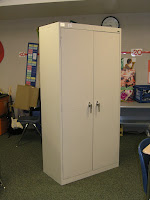I am proud of my newfound passion for 3 Act lessons and the final product for my File Cabinet lesson. However, I am even more proud of:
- My students for their interest, critical thinking, and assistance with Post-Its and filming
- My family, friends, and colleagues who took an interest in the project/lesson
- Fawn Nguyen for using the lesson, providing feedback, and sharing her dynamic results, classroom and students with us
- Dan Meyer for calling me 'Crazy Bananas.' I deserve it. I own it proudly!
Here's the story:
In previous years, a Mr. Stadel Geometry class sounded something like this during the surface area unit, "If we covered this object in wrapping paper, we'd need to figure out the total surface area of the solid so we know how much paper to use. Let's use this formula. Blah, blah, blah!"
Cue the sigh, the yawn, the head tilting back, and eyes closing. The class would use a bland formula to trudge through a static textbook question so that they could arrive at some theoretical answer that meant absolutely nothing to everyone, including me at times.
Not this year... Dan Meyer's 3 Act lesson format is here to breathe life into applied math. I was staring at this file cabinet at the back of my room, saw a stack of Post-Its on my desk and thought, how many Post-Its would it take to cover this rectangular son-of-a-prism... and so it began.
 |
| Forget wrapping paper, Post-its FTW! |
Going beyond estimates, students wanted to help and the only thing I felt comfortable having them do was write numbers on the Post-Its and tape down Post-Its that were sticking out. My students were a HUGE HELP! Thanks guys! Knowing I will post my math videos online, I will not include my students in my videos for what I think are obvious reasons.
The math lesson went extremely well. My students calculated the theoretical answer for homework after we watched Act 1, made estimates, and discussed the necessary information in order to answer the question, "How many Post-Its will cover the file cabinet?" The next day we discussed the differnt ways my students calculated. NONE of them used any formula from the textbook. I love it! Students either:
- Found the total amount of Post-Its on each face and found the total sum or
- Found the sum of the areas of each face and divided it by 9 square inches.
I was impressed by their ingenuity, resourcefulness, and independent thinking process. Bottom line: I didn't help. I didn't force-feed them a formula that means nothing to them. Instead, I allowed them to derive the answer. Little voice in my head says, "Derive the answer or formula on your own!" We also discussed potential problems with the theoretical answer as they walked around the cabinet. Check out Act 3 to get a 'handle' on the potential problem. Here's a hint:
 |
| Get a handle on the potential problem. |
I asked my new online math teacher friend Fawn Nguyen if she had done surface area with her Geometry kiddos and I was glad to share File Cabinet - Act 1 with her. Check out Fawn Nguyen's blog here for an exciting read about how her kids responded, their inquisitiveness, ingenuity, and the depth in which Fawn took the lesson. One of my favorite parts was seeing the kids come up to her board and measuring the video display in order to make estimates. They also estimated my height while they were at it... classic! I was flattered and happy that the lesson sparked such a great interest with her and her students. They were so kind to send me a 'thank you' picture. I love it! I shared the story with my class.
Another new online math teacher friend Nathan Kraft simply said, "I'm using this."
I'm glad! I hope you do too! and send me some feedback.
I also sent out the video link to family and friends and got a healthy amount of intriguing responses. My brother, who has great insight regarding the furniture business, was able to eyeball two-thirds of the file cabinet dimensions and had a blast calculating the number of Post-Its. It was fun to go back and forth with him about this. When asking friends what their first question was after watching Act 1, one family friend shared a perspective I wouldn't have thought of in a milion years. Her husband underwent chemotherapy years back and they used Post-Its to count down the days left. They had a pack of Post-Its in the car and counted down each of the 33 days of radiation treatment. This was an extremely touching email as I learned a life-impacting fact, all because of a math video about Post-Its.
As I was busy sticking Post-Its on the cabinet all week, staging the next camera angle, stop motion setup, or editing the video, I was honored to see Dan Meyer's blog post of his weekly Five Favorites - 101Questions [4/28/12]. Yes, Dan is correct that I'm 'Crazy bananas.' I am proud of that title and fully embrace it. I also got this tweet from him:
I don't think I'll be using a Post-It for awhile... and every time I use a Post-It I will think of this math lesson. Enjoy File Cabinet - Act 3.
If you'd like the information for Act 2, email me or post a comment. I'm working on making Act 2 files more accessible or downloadable. Until then, drop me a line!
[UPDATE] Check my 3 Act catalog for Act 2 information and more!
Best,
1131





